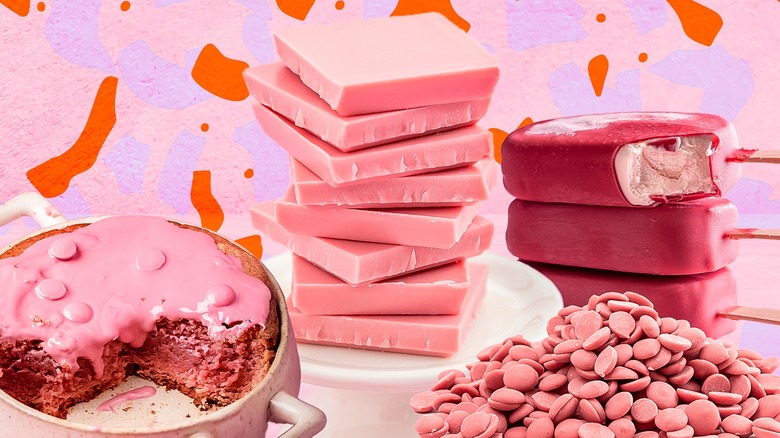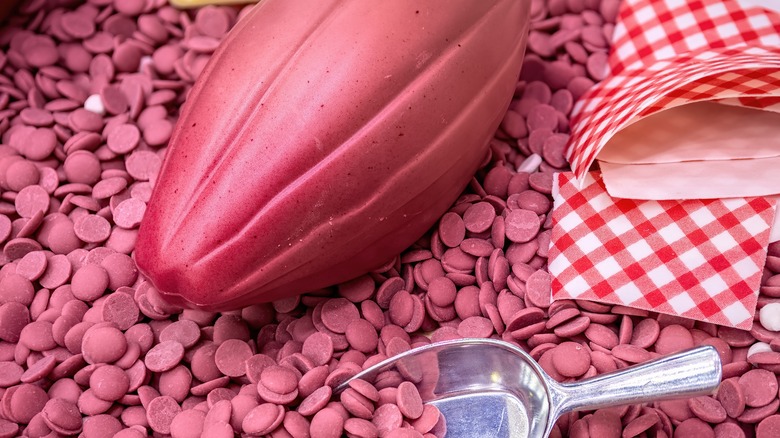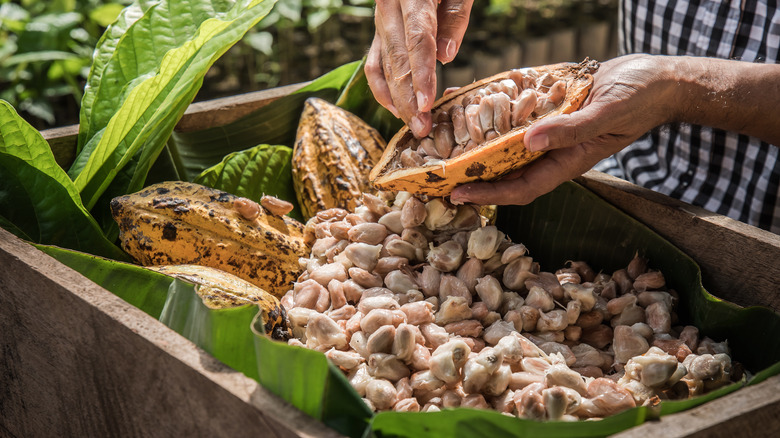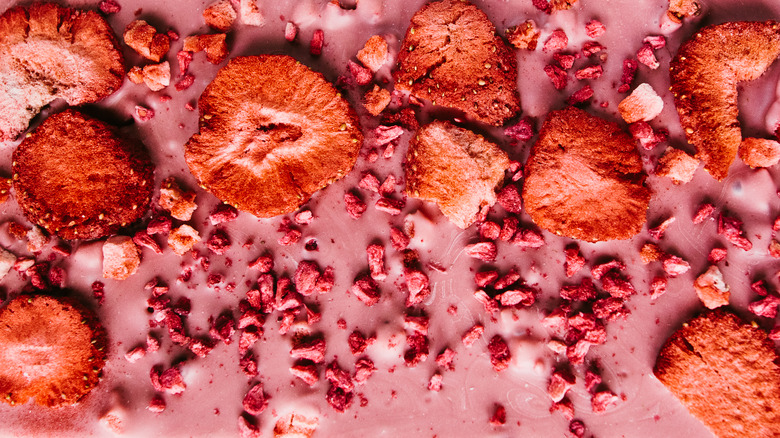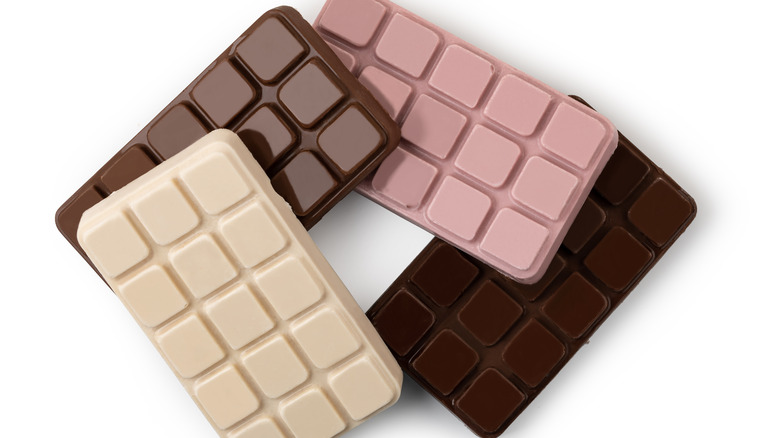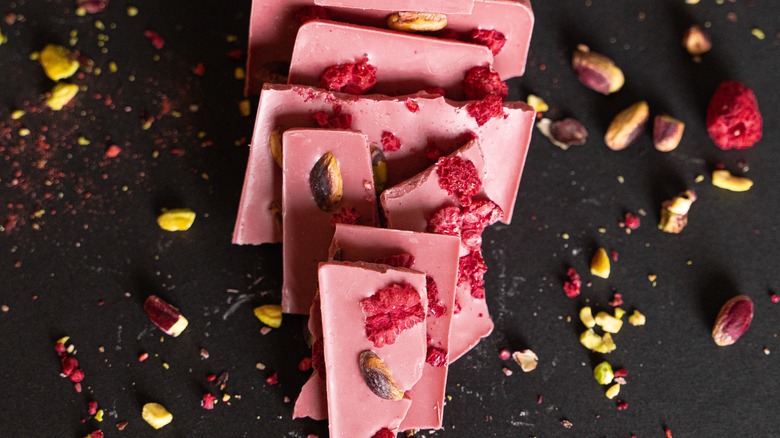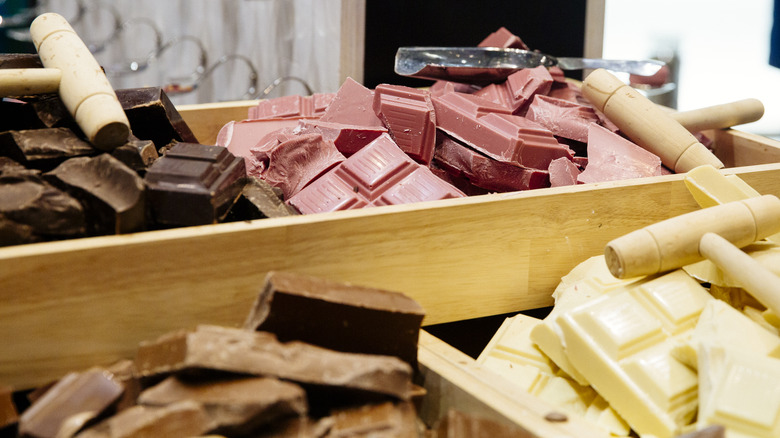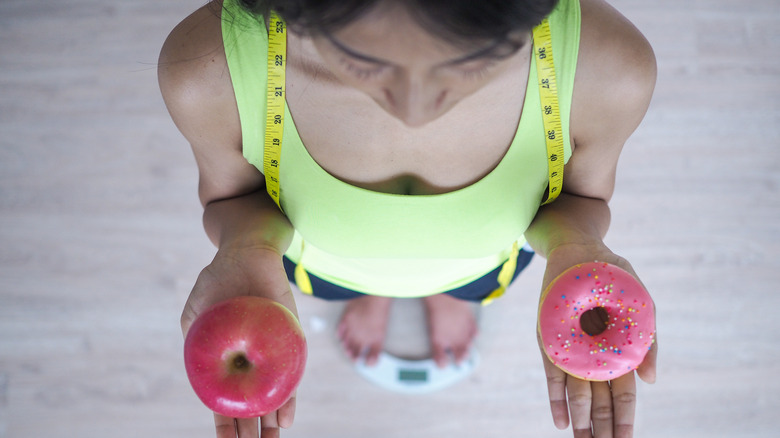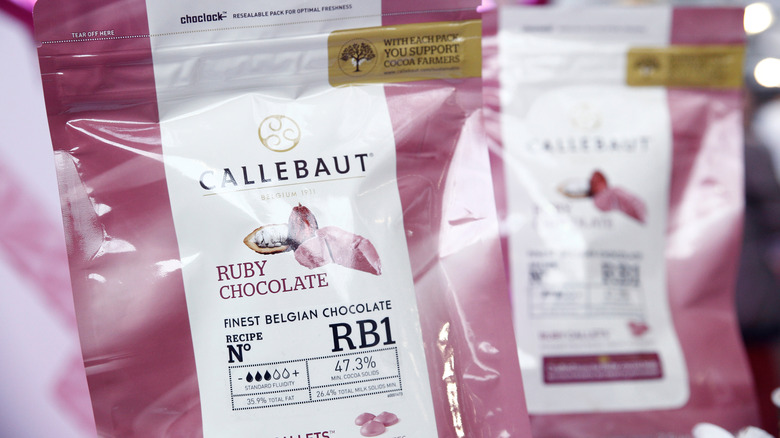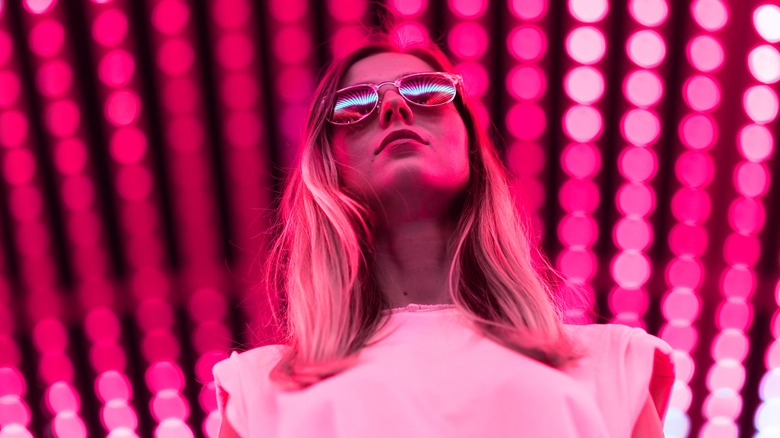What Is Ruby Chocolate And How Do You Cook With It?
In 2017, Swiss chocolatiers at Barry Callebaut introduced a fourth way for chocoholics to get their fix: ruby chocolate. For the first time in 80 years since white chocolate entered the world, the news that a red chocolate now existed caught the excitement and creative attention of every dessertarian — not to mention every dietitian and dentist — on the planet.
The chocolate's research and development was a decade in the making and required the input of 28 global research centers from around the globe. However, ruby chocolate, Barry Callebaut's press release assured the chocolate community, was all-natural, all berry-licious, and all smooth to the taste. News spread fast. In 2018, Barry Callebaut won the NCA award for "Most Innovative Supplier," and ruby chocolate was mentioned in news media, was included in a skit on "Saturday Night Live" in 2019, and was served at the 2018 Academy Awards' official afterparty. In 2019, Barry Callebaut officially released ruby chocolate in North America.
Although it hasn't reached the popularity of milk, dark, or white chocolates, ruby chocolate has continued to attract the sweet teeth of many chocolate connoisseurs. Here's a detailed breakdown of ruby chocolate, sourced from online research — and a dash of personal taste testing on what to expect when encountering a ruby in the wild.
What is it?
Ruby red is a type of grapefruit, and while even grapefruits can be sweet and there are certainly fruit-flavored chocolates (Terry's chocolate fruit, anyone?), we generally don't think of Mother Nature naturally mixing citrus with chocolates.
Enter ruby chocolate. Its origins can sound a bit international in scope, with a European chocolatier sourcing its cocoa beans from Ecuador, the Ivory Coast, and Brazil, and launching the red confection in China. Topping off this global effort, the Chocolate Journalist noted, the foodies at Barry Callebaut ensured chocoholics that ruby chocolate's fruity taste was all-natural. Ruby chocolate was also more "chocolatey" than its older white sibling; as reported by Read Cacao, ruby chocolate's cocoa solids make up a hefty 47% of the finished product and include cocoa mass, while white chocolate usually tallies less than 40% cocoa solids and is all cocoa butter.
Some critics were not — and they still are not — very happy about this fourth chocolate. According to Nest and Glow, ruby chocolate is more of a marketing ploy to cash in on its color and sorely lacks when it comes to delivering a unique taste. But even if ruby chocolate is made through some food science, we have to bear in mind that so is any chocolate. After all, a milk chocolate Hershey bar doesn't grow on trees, while pink cocoa beans actually do.
How is it made?
At first glance, Ruby chocolate might have been named after cartoonist Rube Goldberg, who gained fame for designing complicated machines to perform simple tasks. Back when ruby chocolate was announced, chocolatiers speculated if the food scientists at Barry Callebaut had genetically modified an unfermented cocoa bean or simply went overboard with red food dye or maybe adapted the original process used to make red velvet cake – adding Dutch cocoa powder to buttermilk.
Actually, any guesses about adding acid wouldn't be too far off the mark. We wouldn't think that adding anything acidic could create a sweet confection but according to the ruby chocolate's U.S. patent, the process for making red cocoa involves treating dried unfermented cocoa nibs. Fermentation changes the beans' natural red color to the chocolate color and taste that we all love. For ruby chocolate, the nibs were soaked in an acidic solution for 24 hours, which retains the natural red color and tart raspberry taste for processing, but also prevents the beans from acquiring chocolate flavor.
The soaked nibs are then dried and broken up into flakes and melted into a liquid paste. Like white chocolate, sugars, vanilla, creams, and butter are added to give the ruby chocolate the consistency of regular chocolate. No artificial colors or flavors are added to saturate the red. But, unlike some alternative chocolates that you can make at home, such as changing white chocolate to blond, ruby chocolate comes straight from the cocoa beans.
What does it taste like?
Ruby chocolate qualifies as chocolate. But for some connoisseurs, the real test comes with the first bite. As its color implies, ruby chocolate has a sweet berry taste and is very smooth, much like a strawberry or raspberry–infused white chocolate. The Food Republic says that ruby chocolate doesn't have any fruit pieces or juice; the taste comes directly from the unfermented cocoa solids. There are now a number of varieties of ruby chocolate, with some having more cocoa than others for a stronger taste.
Ruby chocolate also has a whiff of fruit. For those who love the aroma of warm cocoa, ruby chocolate packs a punchy fruit scent, as noted by Dessertisans. No overpowering chocolate or sweetness lingers in the air. To be sure, ruby chocolate isn't for everyone. If you don't like fruit candy or anything to do with raspberries in general, ruby chocolate is probably a hard pass. Even some experts are lukewarm about it; chef Jacques Torres disclosed that his best-kept tip about ruby chocolate was to "stay away from it." For Chef Torres, ruby chocolate was more about fashion and marketing than the real deal.
How does it compare to other chocolates?
Ruby chocolate can stand on its own merits, but, like any sibling rivalry, comparisons to milk, dark, and white chocolate are inevitable. It's understandable, given that there are easily a dozen types of baking chocolate, each with unique characteristics and flavors. From creamy to complex and bitter to bittersweet, cocoa comes in a variety of textures, hues, and flavors.
Ruby chocolate occupies a middle ground, color- and taste-wise. It's not as creamy as milk, or as bitter as dark chocolate. It is creamier than white chocolates thanks to its genuine cocoa solids. Spinnaker Chocolate explains that basic ruby chocolate contains 1.5% cocoa solids, 12% milk solids, and 20% cocoa fat, which makes its cocoa flavor much more subtle. Its fruity flavoring masks the cocoa even further, and ruby chocolate is also the only chocolate variety to have that added natural flavor.
While snacking on ruby chocolate bars poses zero problems — except for the waistline, of course — the chocolate does react differently than milk and dark when cooking and storing it. Ruby chocolate can discolor when wet or heated, and confectionery chefs will need to adjust their recipes and techniques accordingly to compensate.
How many varieties are there?
Forrest Gump's famed box of chocolates has long since overflowed thanks to the fourth chocolate's introduction. Barry Callebaut's ruby chocolate debut inspired confectioneries to infuse the recipe with dozens of pink variations.
A simple Internet search reveals numerous ruby chocolate creations. Some companies add nuts, creating almond clusters, or dot ruby chocolate bars with pistachios. Others supplement ruby chocolate's sweet and sour fruity flavor with the real thing by mixing in passion fruit and grapefruit pieces and extracts, or even making ruby chocolate versions of famous brands, such as Nestlé's ruby chocolate KitKats, available in Japan. If ruby chocolate's 47% cocoa is too high, some companies have lowered it to around 30%, with a dash of cocoa liquor for extra punch. However, per the Huffington Post, all chocolate manufacturers use Barry Callebaut as their industrial supplier for the red stuff, with most of the ingredients added. So, regardless of brand names, all ruby chocolate originates from Barry Callebaut.
Barry Callebaut hasn't been sitting on its laurels, either. The company introduced ruby chocolate powder, ruby chocolate chips, and nibs for chocolatiers to don their chef hats and experiment. Do note that, when browsing shelves, just because a chocolate is red, it isn't necessarily ruby chocolate. Of the eight types of cocoa powder, for instance, red/rouge powder isn't the same as ruby chocolate. Rouge powder is bittersweet in taste, and any cook who accidentally swaps out ruby with rouge will be in for an unpleasant surprise.
Where can I find ruby chocolate?
In 2017, ruby chocolate took the confectionery world by storm, and it's readily available these days in retail shops and online. A quick look at the websites of Walmart and Kroger shows a limited selection of ruby chocolates, while Amazon offers a greater assortment of brands, styles, sizes, and consistencies.
Of course, ruby chocolate can be ordered directly from Barry Callebaut. The chocolatier's prices are a bit higher than other brands, and for good reason. According to Alicja Confections, Barry Callebaut's recipe calls for Trinitario cocoa beans from specific regions in Brazil, Ecuador, and the Ivory Coast, which grow only under certain conditions and climates to achieve its red coloring and taste. Other confectioneries might be tempted to simply use red dye and artificial coloring to mimic the all-natural taste and colors of ruby chocolate and keep costs down, but doing so would violate the FDA's specifications that anything labeled "ruby chocolate" cannot have added ingredients to "imitate the flavor of chocolate, milk or butter, berry, or another fruit." Barry Callebaut's sourcing — and its patented process and trade secrets — makes ruby chocolate more exclusive and pricier than other chocolates.
The exclusivity and pricing have also deterred some chocolate brands from offering ruby editions. For instance, Whitakers has passed on developing ruby chocolate, citing greater demands for the traditional milk and dark varieties, along with the extra expense of replicating the manufacturing process.
How do I cook with it?
Anyone who has poured hot water from a chocolate teapot can attest that cooking with cocoa is more complicated than it seems. Ruby chocolate requires an extra step to adjust to its unique color and flavor.
The red color can make your pastries eye-catching but watch out when folding ruby chocolate into dough. The chocolate's acidity gives it that vibrant hue, and exposure to moisture will upset the delicate pH balance and turn the chocolate into an ash-like grey, according to Barry Callebaut. Barry Callebaut has tips to keep ruby chocolate's red color intact throughout the cooking process. Sure, you can add some red food dye to touch up any gray spots but to keep it natural, add some acid back in, such as fruit purees, lime and lemon juice, or fresh raspberries to get that pH back to 3.3-3.8, Barry Callebaut notes. The extra acidity will change your recipe's texture and taste of your recipes, although more neutral foods, like crushed beetroot or even dried rose petals, can restore color to the graying chocolate.
To make fruit-flavored sweets, add some citrus. Ruby chocolate goes well with any baked goods that call for fruit. If you make ice cream or yogurt, swirl in ruby chocolate along with other frozen berries to create a smoothie or ganache. You can easily find ruby chocolate frosting coating donuts, biscuits, and filler for many pastries. Ruby chocolate powder can flavor hot cocoa or a glass of Nesquik.
It's fruity, but is it healthy?
While we can stop believing some chocolate myths, like that it will automatically cause us to become overweight and give us acne, we do have to face the harsh reality that no chocolate is 100% healthy. Though we all know that it contains antioxidants, the saturated sugar and fats will take a toll on our bodies.
That said, chocolate, and ruby chocolate, in particular, does have some other positive health properties. Dr. Chockenstein has diagnosed that ruby chocolate is a source of minerals, such as magnesium, along with fiber and iron that help nourish our body systems, while also having less sugar than milk and dark chocolate. Other nutrients include selenium, potassium, and zinc to promote our immune systems, and some flavonoids, which help us maintain healthy skin, as per the Royal Examiner. According to its nutrient label, as provided by Recipal, ruby chocolate also contains 9 grams of protein per 100-gram serving, 260 mg of calcium, and hefty doses of both riboflavin and vitamin B12.
True, eating a ruby chocolate bar isn't exactly the healthiest choice but don't forget that its fruit flavor makes it the perfect pairing with fruits and yogurt, which are certainly part of a balanced diet.
How do I store it?
Ruby chocolate might differ from other chocolates in look and taste but it is still chocolate at its core. This means that any techniques you use for storing chocolates can be generally applied to ruby chocolate as well. Barry Callebaut notes that ruby chocolate, like most chocolate, is best kept in its original containers and wrappers. Keep the chocolate in a cool dark environment, like your cupboard or in a sealed candy jar. If you decide to re-house your chocolate — maybe to avoid temptation — bear in mind that ruby chocolate is sensitive to moisture, light, and oxygen, which can lead to discoloring (including turning to grey when exposed to prolonged sunlight, as reported by Cocoa and Heart), changes in taste, and bacterial contamination.
Despite its taste, ruby chocolate doesn't have any fresh fruit in it, so no need to worry about spoilage — and no reason to keep your ruby (or any) chocolate in the fridge for the long term. On the other side of the temperature spectrum, if you happen to have some extra melted ruby chocolate left over after coating your cookies and pastries, don't toss it out or lap it up. The best way to store leftover melted chocolate is to pour it out on some lined parchment paper. Pop the parchment into the fridge just until it solidifies. Then, break up the chocolate into pieces and store it in resealable bags at pantry temperature until needed.
What is the future of ruby chocolate?
Back in 1939, a young girl clicked her ruby slippers three times and went back home to a black-and-white world... sans slippers. But unlike Dorothy Gale, who returned to Kansas without her red shoes, ruby chocolate is here to stay in our multi-color world, and there is no turning back the clock.
When Barry Callebaut introduced ruby chocolate, Peter Boone, the company's chief innovation and quality officer, described its newest lineup as a generational shift in the company's 175-year history. Ruby chocolate, Boone said, was a "hedonistic indulgence" for millennials. For the millennial generation, pink was its color — the hybrid hue was softer than its parents' color, harsh red and glaring white, and appealed to women and men, as reported in The Cut.
Foodies have continued to embrace pink. From pink restaurants to pink sauce to pink fried eggs, and especially to 2023's smash hit movie, "Barbie" (Malibu Barbie cocktails, anyone?), pink will surely be around for the long haul. However, ruby chocolate hasn't taken the world by storm quite as much as one might have expected. Other food color trends have come and gone, and ruby chocolate is not going to overtake its older siblings anytime soon. But unlike other fads that cash in on food dyes and purported health properties, ruby chocolate, with its all-natural color, unique fruit taste, and adaptability, may eventually find a place in every home. And that should tickle us all pink.
